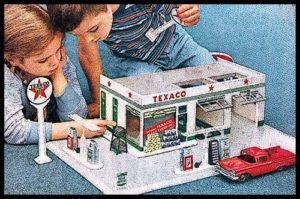Full service vs. Self serve: fill ‘er up, Mr. Recruiter?
 Remember full service gas stations? Most of us ‘of a certain age’ do. You’d pull up, an attendant (usually teenage and bored) would appear, ask you how much gas you wanted, then would proceed to clean your windshield and pump the gas. The more enterprising ones would check your oil, tire pressure, and radiator. And sometimes you got trinkets like glasses, toys, and trading stamps!
Remember full service gas stations? Most of us ‘of a certain age’ do. You’d pull up, an attendant (usually teenage and bored) would appear, ask you how much gas you wanted, then would proceed to clean your windshield and pump the gas. The more enterprising ones would check your oil, tire pressure, and radiator. And sometimes you got trinkets like glasses, toys, and trading stamps!
These faded away in the 1970s (well, unless you live in New Jersey or – until recently – Oregon). Why? The OPEC oil crisis of the early 70s caused significant increases in gas costs – so consumers were willing to forgo ‘full service’ to save a few pennies by pumping the gas themselves. But after the crisis faded, why didn’t full service stations come back? A few reasons: a) people got used to pumping the gas themselves; b) gas stations realized they could cut labor costs by cutting attendants; and c) independent stations realized they could compete against the ‘big brands’ by selling gas cheap. There were continued skirmishes between the full serve and self serve industry groups, but as anyone who drives quickly realizes, self serve won the war. Gas pumps are found at supermarkets, convenience stores, flower shops, and – occasionally – automotive repair shops. If someone suddenly appears at your window asking for your money and your keys, you are more likely to drive away in fear than to give it to him or her.
And what, pray tell, does this have to do with job boards and recruiting sites?
Well…think of job boards as the ‘self serve’ pumps of recruiting. Before they came along, an employer had to work with a recruiter (expensive) or a newspaper (still expensive) or hang signs on telephone poles (not expensive but time consuming and maybe a little embarrassing). Suddenly, a job board allowed the employer to place and pay for the ad online (pump the gas), without interaction with a salesperson (friendly attendant). The cost was much lower. The effectiveness seemed similar to previous methods, or maybe even better. And the employer could do everything from the comfort of their own cubicle. Needless to say, job boards flourished.
Just as it took self serve pumps about 20 years to become ubiquitous, it also took job boards about 20 years to become the primary paid recruitment marketing tool for most employers. But…as with those self serve pumps, job posting spread outside job boards, to other sites like blogs, hubs, and portals. Employers wanted more than ‘just a job posting’ – and sometimes they were even willing to pay for those additional services. Sites like LinkedIn provided recruiter-focused search tools. Aggregators like Indeed provided pay per click and analytics. And sites like TheMuse provided the amorphous ’employer branding’ visual tools that were seen as the next step in recruitment marketing. More tools, more services.
So are we moving back to full serve? I don’t think so…but I think sites and tools that incorporate features mimicking ‘full serve’, either in reality or feel, have become more popular with employers. Customers want more for less – they don’t want to feel like they’re poking around on the bargain table when looking for candidates, and they almost always need help in figuring out a) who they are looking for, and b) how to find them. Anything a recruiting site can do to provide more service – and results – is a differentiator. In other words, ‘no, we don’t just offer job posts, we also provide analytics, assessment, targeted emails, etc., etc., etc.’. IE, ‘you can get the gas AND the trinkets!’.
So…fill ‘er up?
[Want to get Job Board Doctor posts via email? Subscribe here.]. [Check out the JobBoardGeek podcast archive!]
[…] gates or telephone poles (not expensive but time consuming and maybe a little embarrassing). JobBoardDoctor.com compares this process to online job sites, and it is particularly true of education job […]